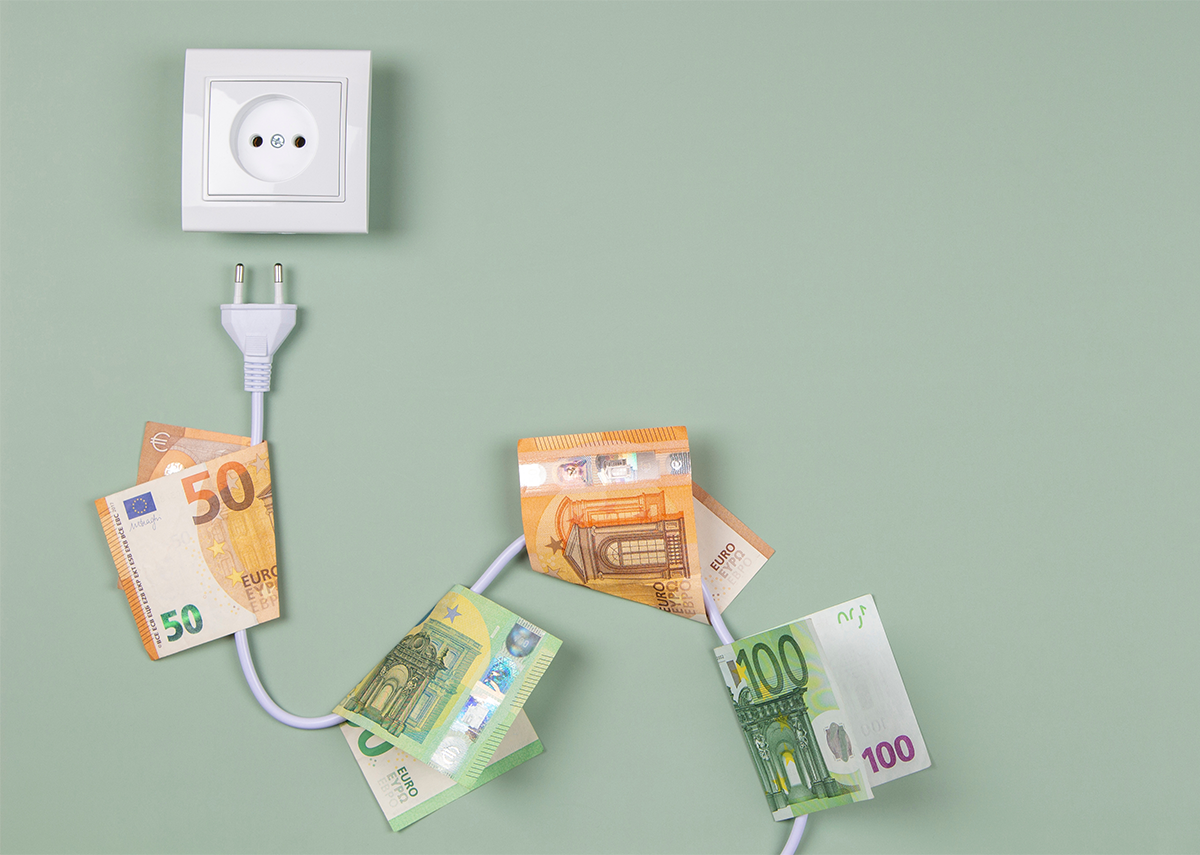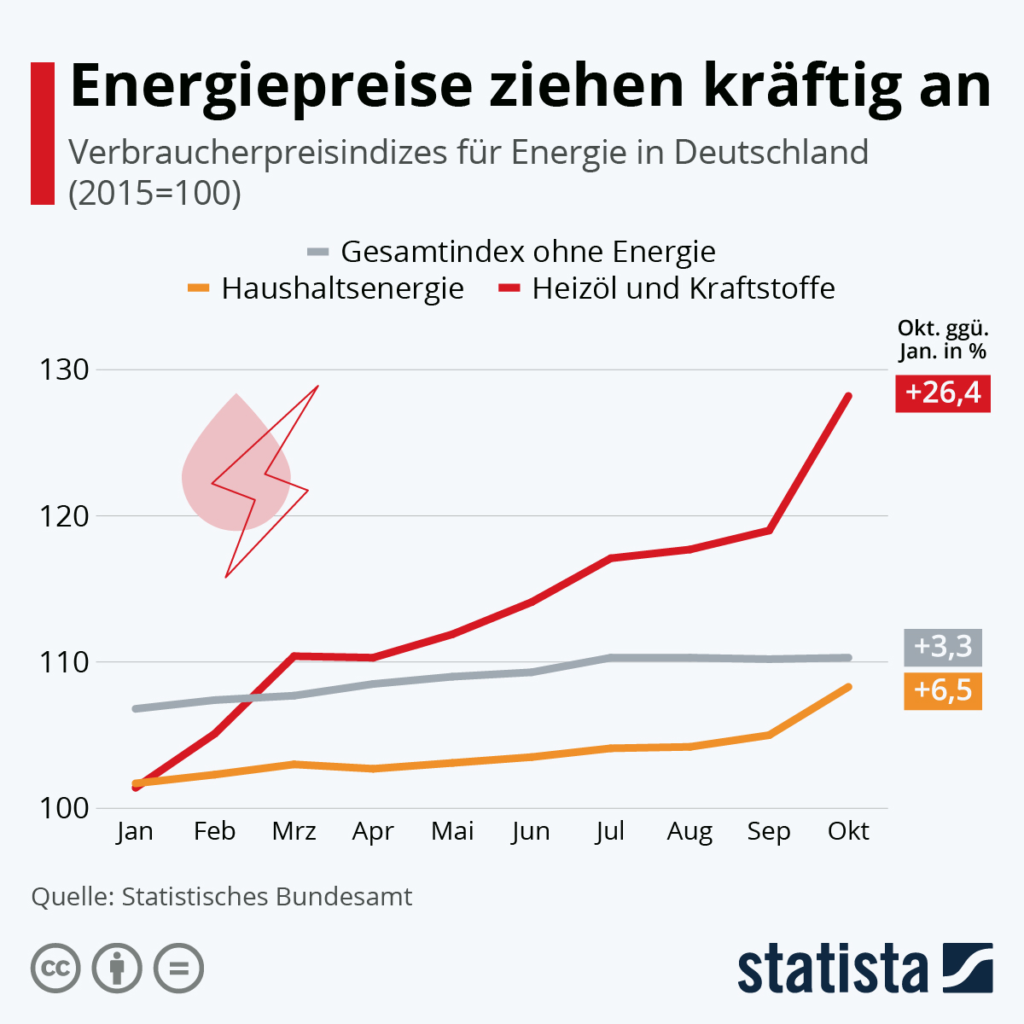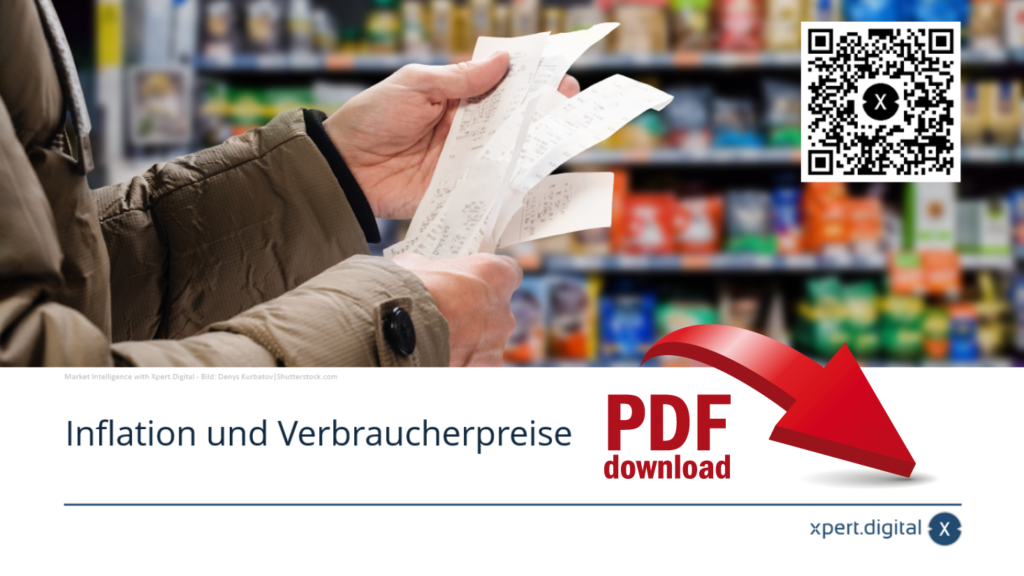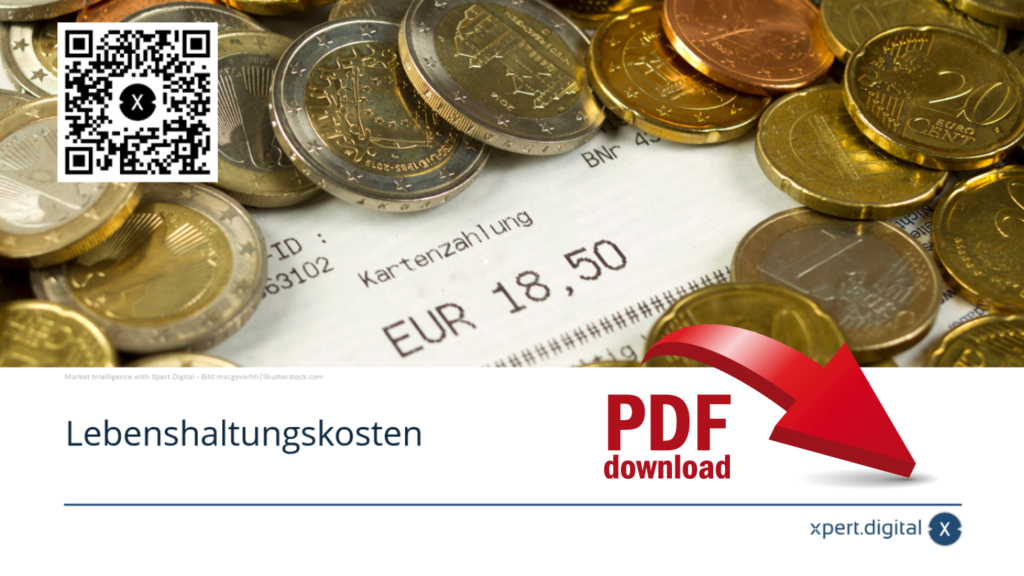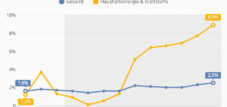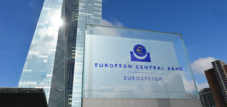Inflation: Energy prices are rising sharply
Language selection 📢
Published on: November 10, 2021 / update from: November 10, 2021 - Author: Konrad Wolfenstein
Consumer prices for household energy, heating oil and fuel have risen significantly since the beginning of the year. This is shown by the graphic based on the latest figures from the Federal Statistical Office. Prices for household energy have increased by 6.5 percent since January. This includes the prices for electricity, gas and other fuels. The prices for heating oil and fuel rose by over 26 percent in the same period. The overall consumer price index excluding energy, however, only rose by 3.3 percent.
Whether inflation as a whole will weaken again next year is controversial among experts. According to the Federal Ministry of Economics, price increases for producers and consumers are primarily due to temporary special developments: raw material prices have risen noticeably within a year. However, a large part of the price rally simply represents a catch-up to pre-crisis levels. Secondly, measures from the climate package came into force at the beginning of the year. In particular, the introduction of CO2 pricing for the areas of transport and building heating as well as the increase in vehicle tax for certain vehicles with combustion engines should be mentioned here. Thirdly, the inflation rate rose from minus 0.3% to 1.0% from December 2020 to January 2021 primarily because the temporary reduction in sales tax rates had expired. Many central banks assess the situation similarly and do not raise their key interest rates, as the graphic shows. Central banks have the monetary policy tools at their disposal to counteract inflation: They could end the flow of money, increase key interest rates and thus reduce demand for credit and money creation.
Price development basically shows the change in the amount that has to be invested to purchase goods and services. The Federal Statistical Office publishes data on price developments in Germany. The most important indicator for the development of consumer prices is the inflation rate in Germany. This refers to monetary devaluation, which is characterized by a constant rise in the price level for end products (consumer goods, capital goods). The calculation of inflation is based on the price development of a defined shopping basket made up of different everyday products and services. What is particularly important from a consumer perspective is the price development for energy and raw materials, which in turn has a major influence on the prices of consumer goods and food.
Calculating the inflation rate
The term inflation refers to the devaluation of money (decrease in the value of money), which is characterized by a constant increase in the price level for end products (consumer goods, capital goods).
The inflation rate is calculated from the price increase of a product basket defined by the Federal Statistical Office. This shopping basket contains as representative a selection as possible of various everyday goods and services on which an average end consumer or household in Germany spends money over the course of the year. This includes, among other things, expenses for food, clothing, rent, electricity, telecommunications, leisure expenses and raw materials (e.g. gasoline, heating oil) as well as government fees and taxes. The shopping cart is constantly updated so that the product variants that are currently frequently purchased by consumers are always included in the price monitoring. The average price development for a type of goods is then weighted by the share of expenditure that private households in Germany spend on this type of goods. The inflation rate therefore depends not only on how the prices for the products in the shopping basket change, but also on the weight with which the price developments of the individual goods are included in the consumer price index. The so-called weighting scheme determines the weight of the goods and services in the consumer price index. The weighing scheme is adjusted every five years.
The price development of this basket of goods, ie private consumption expenditure, is reflected by the consumer price index. The increase in the consumer price index shows the inflation rate.
Figures on the inflation rate in Germany, the EU and the world
In 2020, the inflation rate in Germany was 0.5 percent. This meant that the German inflation rate was just below that in the European Union (see the inflation rate in the EU and euro zone). The price increase in the euro zone was around 0.3 percent in the same period (see also the inflation rates in the world regions). The country with by far the highest inflation rate in the world in 2019 was Venezuela with an inflation rate of around 19,906 percent. The global inflation rate was 3.51 percent in 2019.
Price development in Germany
Price development basically shows the change in the amount that has to be invested to purchase goods and services. The Federal Statistical Office publishes data on price developments in Germany. The most important indicator for the development of consumer prices is the inflation rate in Germany. This refers to monetary devaluation, which is characterized by a constant rise in the price level for end products (consumer goods, capital goods). The calculation of inflation is based on the price development of a defined shopping basket made up of different everyday products and services.
What is particularly important from a consumer perspective is the price development for energy and raw materials, which in turn has a major influence on the prices of consumer goods and food. The price development of crude oil has been rather unstable in recent years. After rising prices in 2012 to an average of 109.45 US dollars per barrel, the price of crude oil fell to an average of around 57.72 US dollars per barrel in 2020.
The share of consumer spending is based on price developments in the respective areas. The largest consumer spending in 2019 was in the area of housing - around 34.6 percent of a household's consumer spending in that year was spent on housing, energy and home maintenance. The prices for land ready for construction in Germany have also increased. While a square meter of building land in Germany cost an average of 128 euros in 2011, an average of 190 euros had to be spent on it in 2019. The cost of electricity has also risen steadily in recent years. The index for the development of electricity prices for households increased from 81 index points in 2000 to 186 index points in 2020.
Cost of living
Cost of living refers to the financial burdens that arise, for example, from rent, electricity or food. Expenses for housing, energy and housing maintenance represent the largest item in the cost of living for private households in Germany. Housing costs for an average household in Germany amounted to around 890 euros per month in 2019. Overall, average private consumer spending amounted to 2,574 euros per month.
How much do Germans spend on food?
Spending on food, beverages and tobacco products totaled 254.88 billion euros in 2020. The share of total private household spending on these consumer goods was around 15.5 percent in 2020. When comparing the countries of the European Union with regard to consumer spending on food and beverages, Germany comes first ahead of France when looking at the total figures. When comparing consumer spending on food, countries such as Romania, Lithuania and Estonia are in first place in Europe.
How does inflation affect the cost of living?
The cost of living also depends on the level of inflation. The inflation rate in Germany indicates the change in the consumer price index compared to the previous year or month. The Federal Statistical Office compiles the consumer price index for Germany based on the so-called shopping basket. In Germany, this shopping basket includes around 650 goods and includes everyday products such as food (FMCG) or petrol, consumer goods such as clothing or technical devices, and services such as visits to the hairdresser or cinema tickets. In 2020, consumer prices in Germany rose by 0.5 percent based on the inflation rate.
Xpert.Digital – Konrad Wolfenstein
Xpert.Digital is a hub for industry with a focus on digitalization, mechanical engineering, logistics/intralogistics and photovoltaics.
With our 360° business development solution, we support well-known companies from new business to after sales.
Market intelligence, smarketing, marketing automation, content development, PR, mail campaigns, personalized social media and lead nurturing are part of our digital tools.
You can find out more at: www.xpert.digital – www.xpert.solar – www.xpert.plus



